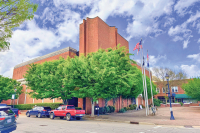Waynesville leaders compromise on parking in front of businesses
Developers in Waynesville rejoice: your customers may now park in front of your buildings. Sometimes. In some places.
The new rules, passed after nearly two years of deliberation, will allow limited parking in the front of businesses for high-traffic commercial districts, something that was strictly forbidden under the town’s smart growth policies, much to the chagrin of some developers and business owners.
Parking design has been a controversial topic since 2003, when the town’s new land-use plan relegated parking to the side and rear of buildings in favor of a streetscape defined by building façades — a more attractive option than asphalt parking lots.
But a committee tasked with reviewing the town’s land-use plan over the past year recommended the town allow some parking in front buildings.
After two months of debate of their own, the town board was split 3-2 on exactly how much parking should be allowed in front during last month’s town board meeting.
Town leaders ultimately did not allow as much parking in front as the land-use review committee or the town planning board suggested. Instead of allowing two rows of parking spaces in front of the building, the town board cut that down to just one row.
Related Items
Town board members Libba Feichter, Wells Greeley and LeRoy Roberson voted to limit parking in front to just one row.
Greeley, who wasn’t on the board when the original ordinance was hashed out, said he was pleased with both the process and the result. Greeley said that he knew coming in that the standards would be a challenge — the parking provisions in particular.
He said that he feels like the end result was a good compromise between the pro- and anti-parking factions.
“I think this strikes a compromise as being now commercially friendly but yet still trying to keep the façades and the front of the buildings maintained,” said Greeley.
Roberson said that he was also pleased with the eventual outcome of the months of discussions and debates.
He also came to the board after the initial statutes were penned, but said that the cleaned-up version will lay a good framework for future development.
“I just think it gives it a better look,” said Roberson. “Instead of having another Russ Avenue on South Main, you’ll have something that’s more appealing and something that will function better overall.”
Mayor Gavin Brown and Alderman Gary Caldwell sided with the committee in wanting two rows.
Caldwell said that, while he’d never be completely happy and did vote against the parking proviso, the overall compromises that were reached were workable.
Town Planning Director Paul Benson said the idea was to offer a clean and inviting aesthetic, while still giving businesses, and their customers, workable parking.
“The concept of one row is that it sort-of replaces on-street parking in places where you can’t have on street parking, and still keeps buildings pretty close to the road,” Benson said. “I think [the aldermen] recognized that a limited amount was probably desirable, at least in some locations, but they didn’t want to go too far.”
What that means will differ greatly for businesses and developers on the ground from district to district, and sometimes even from case to case, said Benson.
“It varies from no parking in front, like in the central business-type districts, to maximum parking in front with a controlled-use permit,” said Benson, referring to the new stipulation that allows some developers to ask that their property be made a special zone, with site-specific conditions.
Ingles on Russ Avenue, which is pursuing a major expansion, is the first to be granted such a permit.
Not everywhere in town, of course, would be privy to parking-in-front. For businesses, it’s limited to the town’s three major commercial districts — Russ Avenue, the Elwood-Junaluska district and South Main Street — and certain residential districts.









